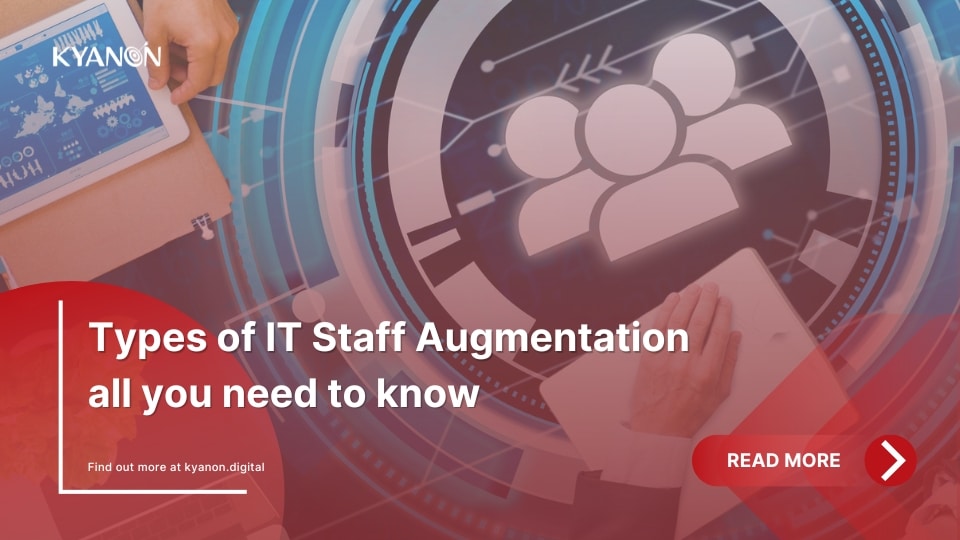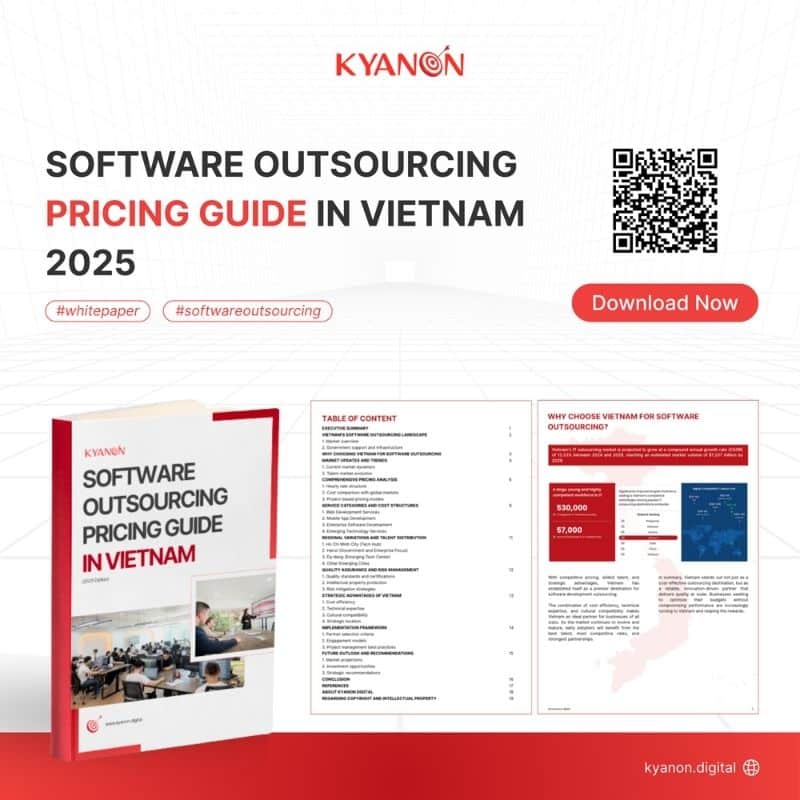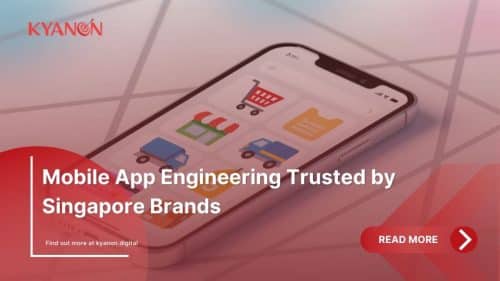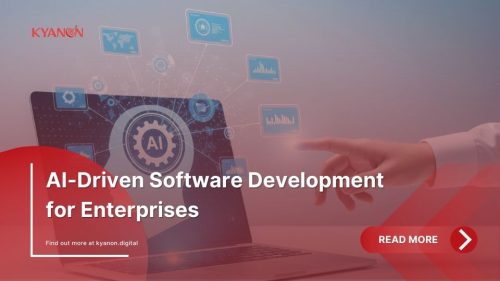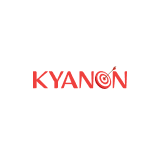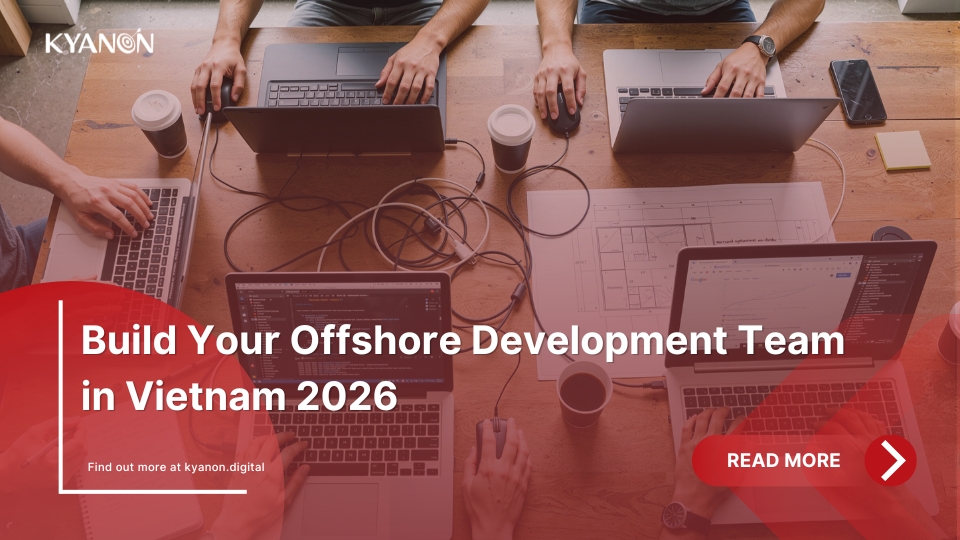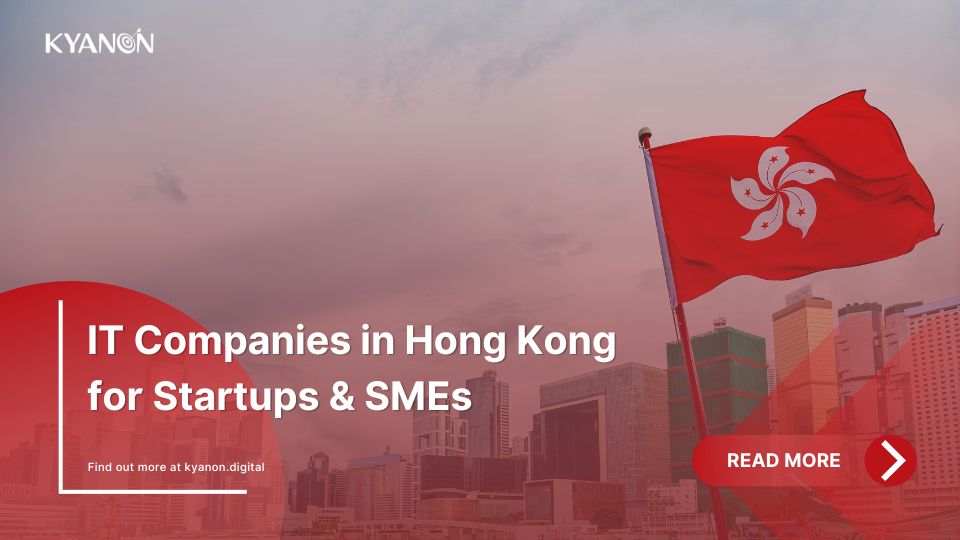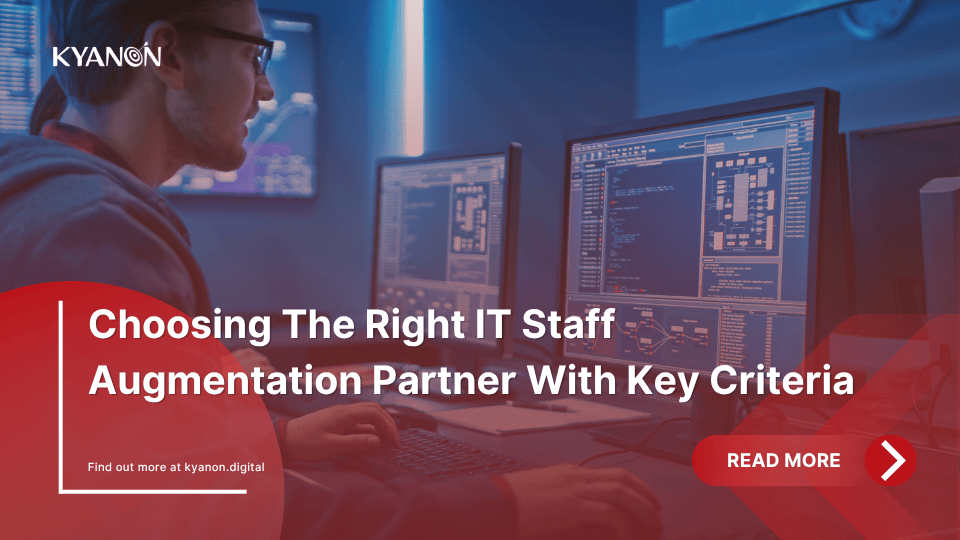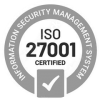The global IT staff augmentation service market is on a rapid growth trajectory – valued at approximately USD 338.8 billion in 2024 and projected to reach USD 970.35 billion by 2033, growing at a CAGR of 13.2% from 2025 onward (Business Research Insights, 2025). This surge reflects rising demand for flexible workforce solutions in an increasingly digital world. Companies are turning to types of IT staff augmentation to overcome talent shortages, meet evolving tech needs, and stay competitive.
To meet evolving demands, IT staff augmentation offers different models to supplement a company’s workforce – project-based, skill-based, onshore, nearshore, offshore, and remote augmentation, each tailored to specific needs.
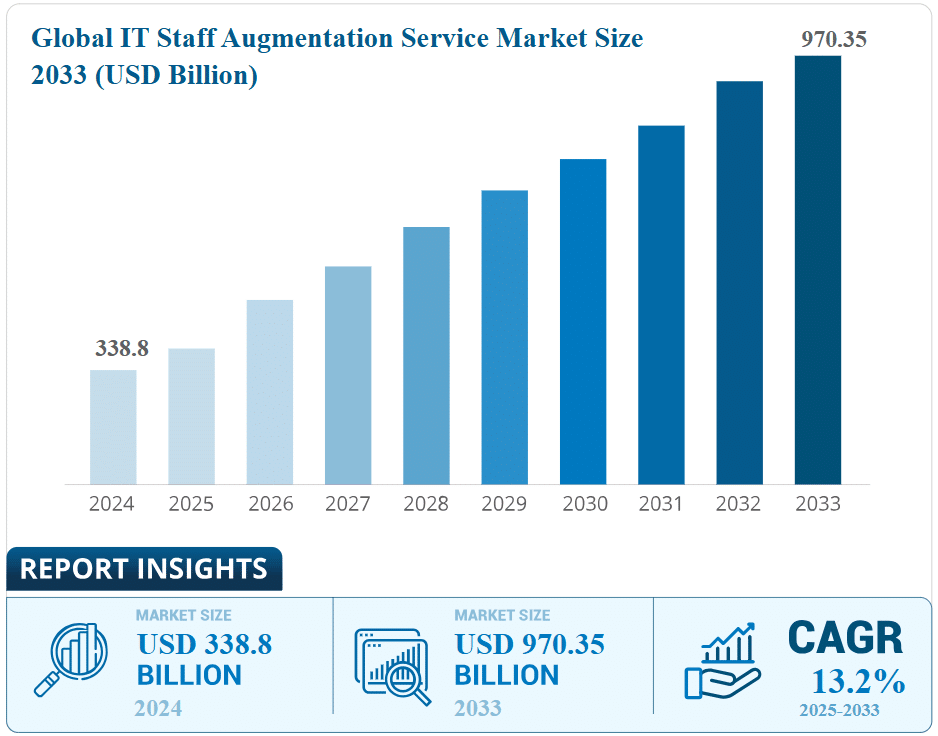
But what are these models – and which one fits your business best? Below, let’s Kyanon Digital break down each type to help you make informed, strategic decisions.
Further Reading
1. Location-based
Choosing the right location-based IT staff augmentation model is critical to balancing cost, communication, and collaboration. Organizations can opt for onshore, nearshore, or offshore staffing depending on their operational priorities.
- Onshore augmentation involves hiring talent within the same country, ensuring strong cultural alignment, real-time collaboration, and easier legal compliance – ideal for high-touch or locally regulated projects.
- Nearshore hiring taps into talent from nearby countries in similar time zones, offering a practical balance of cost-efficiency and smooth integration into existing workflows.
- Offshore models source professionals from distant locations, unlocking significant cost savings and global expertise – suited for large-scale or specialized development initiatives.
The table below offers a clear comparison to assess which model aligns best with your organizational goals.
| Onshore | Nearshore | Offshore | |
| Definition | Hiring within the same country or region | Hiring from nearby countries with similar time zones | Hiring from distant countries, often across continents |
| Key benefits | Real-time communication, cultural alignment, local compliance | Cost-effective, faster onboarding, reduced cultural barriers | Cost savings, access to global expertise, 24/7 development potential |
| Ideal for | High-touch collaboration, domestic regulation-sensitive projects | Agile projects, continuous delivery, shared working hours | Long-term or complex builds, global scaling, specialized development |
Table: Comparison of location-based IT staff augmentation models
2. Project-based vs. Skill-based
Among the various types of IT staff augmentation, businesses often choose between project-based and skill-based models depending on whether they need full project delivery or targeted expertise. While project-based models offer end-to-end support for defined initiatives, skill-based models focus on filling specific technical gaps within existing teams – both enabling scalable, efficient workforce solutions.
- Project-based augmentation assembles a dedicated team to deliver a specific initiative with clear objectives and timelines – ideal for time-bound, outcome-driven engagements.
- Skill-based augmentation focuses on hiring individual experts to fill specific gaps in existing teams, providing flexibility without altering internal structures.
These distinctions help organizations select the optimal augmentation model to meet their specific IT project requirements and operational goals.
| Project-based staff augmentation | Skill-based staff augmentation | |
| Definition | Teams are assembled specifically for a defined project with clear objectives and timelines. | Individual professionals are hired to fill specific skill gaps within existing teams. |
| Focus | Delivering a complete project with a dedicated team possessing a blend of required skills. | Enhancing team capabilities by adding experts with niche or specialized skills. |
| Benefits | Accelerated time-to-market, reduced project risks, focused expertise, and clear project ownership. | Cost-effective way to access niche skills, faster integration, and targeted support for ongoing projects. |
| Flexibility | Allows scaling resources up or down based on project demands, ideal for time-bound initiatives. | Enables precise filling of skill shortages without restructuring the entire team. |
| Ideal for | New product launches, infrastructure projects, or any initiative with a defined end goal and timeline. | Ongoing support roles, filling temporary skill gaps, or augmenting existing teams with emerging technology skills. |
Table: Project-based vs. skill-based staff augmentation overview
Transform your ideas into reality with our services. Get started today!
Our team will contact you within 24 hours.
3. Duration and Scope
As IT initiatives grow in complexity and speed, choosing the right duration and scope for staff augmentation becomes critical to maintaining delivery efficiency. Whether a business needs temporary support for a sprint or long-term engagement for sustained development, augmentation models can flex accordingly.
- Short-term augmentation addresses immediate needs by temporarily filling roles for high-priority tasks or deadlines.
- Full-time augmentation supports ongoing initiatives by integrating dedicated professionals into your core teams.
- Hybrid models combine both approaches, offering organizations maximum flexibility to scale efficiently while retaining institutional knowledge.
To better understand which option fits your business case, review the table below:
| Short-term | Full-time | Hybrid | |
| Definition | Temporary hires brought in for specific projects or urgent tasks. | Professionals hired for long-term roles or ongoing project support. | Combines short-term and full-time models for adaptive resource planning. |
| Key benefits | Faster hiring, reduced overhead, immediate gap-filling without long-term commitments. | Deep team integration, stronger collaboration, consistent knowledge transfer. | Cost-effective scalability, balanced team composition, adaptable to shifting business needs. |
| Flexibility | High
Resources can be scaled quickly as project needs evolve. |
Medium
Suitable for stable environments with predictable talent requirements. |
Very High
Enables dynamic scaling while maintaining a reliable talent base. |
| Ideal for | Tight deadlines, rapid prototyping, short-term implementations, or covering absences. | Continuous development cycles, infrastructure management, or embedded expertise needs. | Organizations juggling multiple timelines, innovation programs, or phased rollouts. |
Table: Duration and scope of IT staff augmentation models
4. Remote vs. In-house
As businesses evaluate different types of IT staff augmentation, one critical consideration is the working model – remote or in-house. This choice directly affects team dynamics, collaboration methods, and overall delivery efficiency. Organizations must weigh the advantages of virtual flexibility against the benefits of on-site integration when augmenting their tech teams.
- Remote augmentation involves hiring professionals who work from different locations, enabling cost-effective access to global talent.
- In-house augmentation places hired professionals physically at the client’s office, ensuring tighter collaboration and hands-on involvement.
The table below highlights key differences to help guide your selection:
| Remote | In-house | |
| Definition | Hiring professionals to work remotely from different locations globally. | Hiring professionals to work physically on-site at the client’s office. |
| Benefits | Global talent access, lower overhead costs, increased scalability and flexibility. | Stronger team integration, real-time collaboration, enhanced control. |
| Communication | Relies on digital platforms for seamless virtual coordination. | Enables direct, face-to-face communication and faster feedback loops. |
| Cost implications | Often more cost-effective due to reduced infrastructure and location-based pay. | Higher costs tied to physical space, equipment, and in-office benefits. |
| Ideal for | Distributed teams, tech startups, or roles requiring niche skills. | Projects needing tight oversight, security, or cultural alignment. |
Table: Remote vs. in-house IT staff augmentation comparison
Case study: How Accenture leveraged skill-based augmentation for scalable growth

A prime example of effective IT staff augmentation is Kyanon Digital’s collaboration with Accenture, where dedicated software engineers were provided to scale their digital capabilities. This engagement exemplifies a full-time, skill-based augmentation model, where individual experts with specialized skills were embedded within Accenture’s teams for sustained periods.
By augmenting Accenture’s workforce with highly skilled professionals focused on long-term support, Kyanon enabled seamless integration, knowledge transfer, and consistent delivery aligned with Accenture’s strategic goals. This approach highlights how skill-based augmentation can drive operational stability while meeting complex project demands in a scalable and flexible manner.
Explore the full case study here.
Search for all types of IT staff augmentation at Kyanon Digital
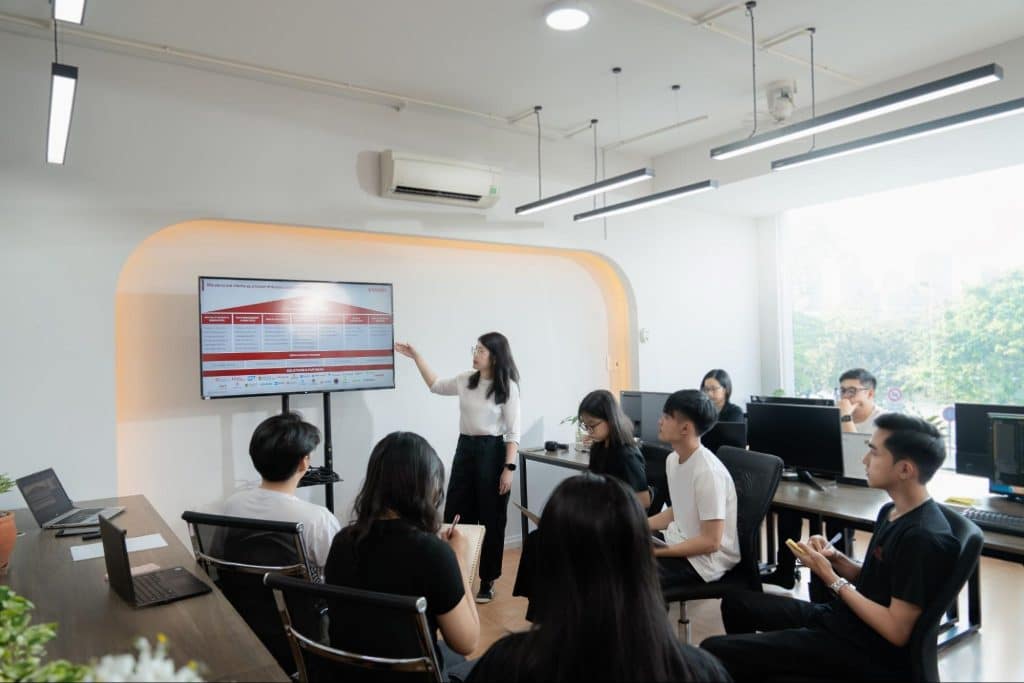
We’re a tech partner, not a recruiter
We build your team strategically, aligning talents with your software vision and roadmap, not just job requirements. With ongoing upskilling and expert support from our Center of Excellence, your talent stays ahead of challenges and delivers results.
Comprehensive talent ecosystem
Kyanon Digital talent ecosystem encompasses over 50,000 technology professionals
- Internal Talent Core: 300+ professionals
- K-Fresh Program: Nurturing Future Digital Leaders from 18 Universities in Vietnam
- External Talent Network: 15,000+ premium candidates
- Partner Network: 1,000+ trusted partners
Your One-Stop Talents Impact Solution
We manage from talent acquisition to HR management for your tech workforce, freeing your team to focus on core business and innovation.
Your shortcut to Vietnam’s outsourcing costs and key market insights.Get the Vietnam Software Outsourcing Pricing Guide 2025

Why work with Kyanon Digital?
With deep experience serving Fortune 500 companies, we deliver tailored, high-impact solutions that meet the unique demands of global enterprises.
Our 500+ IT experts—spanning consulting, project management, technical architecture, software engineering, QA, DevOps, and AI/ML—are committed to excellence in every project.
Certified under ISO 9001, our quality-first approach guarantees precision, reliability, and continuous improvement.
ISO 27001-certified, we integrate robust security into every process, leveraging advanced technologies to protect your data against evolving threats.
Share your requirements with us!
Conclusion
Understanding the various types of IT staff augmentation is essential for building an agile, future-ready workforce. Each model offers unique advantages in terms of cost, control, scalability, and collaboration. The key to successful augmentation lies in aligning the right model with your organization’s project goals, technical requirements, and operational strategy.
Choosing the right IT staff augmentation model is not one-size-fits-all – it’s a strategic decision that can significantly impact your ability to stay agile, innovative, and competitive in the evolving tech landscape. By identifying the best fit for your needs, businesses can effectively bridge talent gaps, accelerate innovation, and maintain a competitive edge in an evolving digital landscape.
For expert guidance tailored to your specific IT staffing challenges, contact Kyanon Digital today and discover how our proven augmentation solutions can drive your business forward.
Key Takeaways:
- Location matters: Onshore ensures alignment, nearshore balances cost and proximity, offshore delivers scale and savings.
- Engagement scope differs: Project-based augmentation fits end-to-end initiatives; skill-based targets specific expertise.
- Duration drives flexibility: Short-term fills urgent needs, full-time ensures continuity, hybrid models offer the best of both.
- Work models shape execution: Remote models offer flexibility and global access; in-house models enable deeper integration.
References
- IT staff augmentation service market size, share, and trends (2024–2033), Business Research Insights
- Comprehensive guide to onshore team augmentation, Softellar
- Onshore, nearshore, offshore: Which IT staff augmentation strategy works best?, BrightBox Group
- Nearshore staff augmentation: What it is and why you need it, Sloboda Studio
- Offshore staff augmentation: A scalable talent solution for startups and enterprises, ScaleUp Ally
- Staff augmentation service models explained, Developers Pool
- The future of IT staff augmentation: What you need to know, Quest Technology Management
- IT staff augmentation: Everything you need to know, Full Scale
- The benefits of on-site vs. remote IT staff augmentation, Swyply
